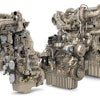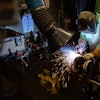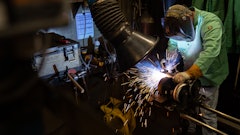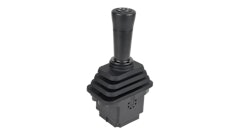The most successful manufacturing organizations in America speak a new language: that of lean manufacturing. Corporations that live lean daily use words such as one-piece flow, 5S and kaizen as part of an overall philosophy that sometimes is misunderstood. “Lean” is simply a manufacturing concept designed to provide the optimum framework for efficient, competitive production. The lean production system is a management philosophy that embraces all aspects of industrial operations by focusing on the reduction of waste from the value stream in order to remain competitive in a world driven economy.
Historically, welding-intensive organizations have adopted new technology more slowly than other industries. As a result, these companies approach welding, fabrication and assembly the same old inefficient way: inefficiently.
So that the welding industry can benefit, Vermeer Mfg. Co. of Pella, IA, and Miller Electric Mfg. Co. of Appleton, WI, have agreed to share information from their lean welding journey. Vermeer’s results speak volumes to the power of lean welding. Here are just a few examples:
- The ability to turn raw materials into finished goods in days, not weeks. Vermeer has demonstrated year-over-year improvements of 200 to 300% for four consecutive years on some lines.
- Year-over-year safety incident and severity rate reductions of 10 to 15%.
Industry Leaders
Some of Vermeer's best-known products include brush chippers, trenching and trenchless equipment and round balers. The company is known for taking care of its customers with better solutions, and for its 4P philosophy: principles, people, products and profit. This philosophy drives all company activity. Vermeer defines lean manufacturing as a time-based strategy that focuses on lead-time reduction through waste elimination in every area of production, including customer relations, product design, supplier networks and factory management. Lean encompasses five key measurable aspects: quality, cost, delivery, safety and morale.
Miller Electric, a manufacturer of welding and cutting equipment and systems, is a wholly-owned subsidiary of Illinois Tool Works (ITW). Miller Electric has incorporated ITW’s philosophy, which aligns well with lean concepts. The philosophy is led by the Pareto principle of 80/20, which provides focus. Focus leads to simplification by empowerment of the people at the right level in a flat, responsive organizational structure.
These processes are really about simplifying and focusing on the key parts of a business. Simplicity focuses action, while complexity often blurs what is important. The process of simplification includes finding ways to simplify product lines, customer and supply base, and business processes and systems. In the end, 80/20 improves quality, productivity, delivery, innovation, market penetration, and ultimately, customer satisfaction.
Many Products, One Process
Vermeer’s lean journey started nearly a decade ago, with lean welding becoming an emphasis in 2003 when the company committed to using a single process (solid wire pulsed gas metal arc welding, or pulsed MIG) for all of its production welding. At that time, about 40% of its 220 production welding stations used pulsed GMAW. Also at that time, the company used eight different models of welders from at least three different vendors.
Vermeer’s first steps in lean welding were to standardize on one process for all of its production welding, reduce the number of welder models from eight to two and select a lean welding vendor partner.
Standardizing on new welding technology would provide numerous benefits:
- Simplify welding training.
- Provide flexibility when deploying welding talent in different areas.
- Improve operator performance (higher production rates with fewer errors and better morale).
- Eliminate sources of variability between welding stations and shifts.
- Simplify and streamline maintenance by greatly reducing parts count; maintaining 300 welders of the same design enables maintenance to become very proficient.
- Change the typical vendor-supplier relationship into a vendor-partner relationship where each party contributes more to the value chain and benefits accordingly.
Selecting a Partner
The stereotypical relationship in many industries involves customers, equipment manufacturers and distributors haggling with each other over price. Anticipating the point of negotiation often inhibits each party from understanding each other’s needs, goals and long-term objectives.
To select a new welder, Vermeer welding engineers, operators, area managers and maintenance managers evaluated several different systems and suppliers. They evaluated the welding systems on such traditional criteria as arc performance, reliability/robustness of design, ease-of-use, ease-of-maintenance and flexibility for future enhancements.
There are differences between various welding systems on all of these criteria; some differences are small, others are much larger and very solid reasons to select one particular product over another.
However, evaluating “what’s inside the box” was just a start. One of Vermeer’s core objectives was to align itself with suppliers that embody similar lean principles. A cross-functional team of five Vermeer personnel visited Miller and learned that Miller was doing many of the things that Vermeer dreamed about in its lean journey. These include:
- Supplier-managed inventory
- Daily on-line inventory replenishment
- Building to a customer order, rather than to a short forecast
- Ability to build and ship products in one day
- Same-day shipping of replacement parts
- Some circuit boards built in-house
- A flat, responsive organizational structure
- Employees at all levels empowered to make decisions
- Line employees engaged in managing their own areas of business
One day prior to visiting Miller, Vermeer placed the order for the first 10 of its 300 Axcess systems as a test trial. The next day in Appleton, Vermeer personnel then watched those10 systems being built and shipped to Pella. Ten units were simply part of the trial process. To Vermeer, this signaled that Miller controls the cost of goods sold because Miller does not build up excess inventory (the number of days it takes to convert raw material into finished product is a key lean measure).
To “flatten” the maintenance process, Vermeer's maintenance manager and several technicians attended Miller’s service technician training program and became fully certified to perform all maintenance procedures themselves. Being certified enables Vermeer’s maintenance department to manage the welding equipment for optimum performance, and it lowers maintenance costs. For more intensive technical assistance, Vermeer personnel have a dedicated contact at Miller’s Advanced Manufacturing Systems’ group and his direct phone number.
While welding system performance is important, Vermeer placed even more value on the ability to find a responsive welding partner with similar organizational philosophies, structures, objectives and goals. This type of relationship, where both parties are aligned for mutual success, enables the parties to better manage the challenges that arise with any product’s use.
For example, Vermeer wanted its welding systems to track arc-on time, a critical measure of productivity for the welding operators and area managers. Without the ability to establish a benchmark for arc-on time, Vermeer would not be able measure improvements.
Unfortunately, this ability did not originally exist in the welding systems’ software. However, because of the partnership arrangement, Vermeer felt comfortable requesting this capability, and Miller accommodated it. Miller engineers wrote an arc-on time program and e-mailed the program to Vermeer, which then updated the welding system’s software. This enhancement, which took less than two weeks to develop and implement, is now standard on all Axcess welding systems sold, providing a new tool for all Axcess users.
Lean Welding Stations
To install its new welding systems, Vermeer’s maintenance department designed and custom-built its own welding stands that reduces welding equipment footprint to just 9 sq. ft. On the “lower level” of the stand is a 900-lb. drum of wire. Compared to 60-lb. spools of wire, the 900-lb. drum provides a 15-fold reduction in the need to stop welding because of an empty spool. A gas manifold system delivers a constant supply of shielding gas, completely eliminating the need to swap out empty gas cylinders, another common source of “waste” that can be eliminated.
The stand locates the welding power source and operator interface 5 ft. off the floor. This greatly minimizes the amount of dust, metal particulates and other contaminants that could enter the welder, and it extends the interval between preventive maintenance sessions.
The Miller-supplied AA40G wire drive motor assembly feeder is mounted on a 15-ft rotating boom, also designed and built in-house. A boom-mounted feeder, coupled with a 15-ft. long welding gun cable, enables the operator to weld at any one of several fixtures with a welding area or easily move around a larger weldment. The stand and boom-mounted feeders nearly eliminate the “cable clutter” often associated with welding stations. Cable clutter presents a tripping hazard, and cables lying on floors get damaged more easily and frequently. A boom-mounted gun also reduces operator fatigue, as the boom takes up some of the weight of the gun.
Each welding stand also incorporates Vermeer’s signal light system, which has five lights that enable operators to indicate the following:
- Green: All is well
- Blue: Bring a paint cart to move finished components to the paint line
- White: Quality problem that requires an area manager’s help
- Yellow: Material shortage. The operator needs more parts
- Red: Line down. The operator can’t work because they need help or parts
At Vermeer, welding operators focus on welding. They do not chase parts or supplies, and they do not bring in unfinished components or remove finished parts. These activities are the responsibility of a “water spider,” a person who focuses on maintaining material flow between work areas.
Each welding station operates on a cart system. The welder has the components for the part/machine he or she is working on now, as well as components for the next one. When a cart is emptied, that signals the water spider to bring a new one. Further, each cart is numbered according to its specific station. By adopting the cart system, Vermeer greatly improved its parts organization, presentation and eliminated the source of many mistakes.
Simplified Settings
In many organizations that perform arc welding, operators are required to consult a book of welding procedures or their work instructions. Older equipment relied on the operator to set individual parameters; in fact, operators often had free reign over them. With unlimited range, most possible combinations would not produce acceptable results.
To eliminate sources of error and variability, Vermeer labels each welding system interface with the appropriate programs and parameters for each particular part or material thickness. To begin welding, the operator first selects the program (the Axcess system stores and recalls multiple programs) that matches the welding wire diameter being used. Then the operator sets wire feed speed, voltage and arc length (“trim”) to match the metal thickness. Vermeer enables its operators to adjust these variables within a certain range to accommodate individual preferences, but it uses the welding system’s software capabilities to lock operators into an acceptable parameter range.
Unlike older welding technology, where individual machines could produce different arc characteristics, every software-driven Axcess system welds the same. Further, the system features a technology that compensates for variations in primary power (the voltage spikes, dips and low- or high-line situations common in many large facilities or companies with multiple facilities). As long as the primary voltage remains within a 190 – 630v AC range, even if it fluctuates wildly within that range, the Axcess system will produce the programmed welding parameters.
By maintain consistency between welding systems, Vermeer can deploy welding operators to different lines or different buildings without any need for additional system training or fear of introducing welding variability.
Weld Area Organization
Vermeer’s welding areas look and function radically different now than they did just two years ago. Outside of every area manager’s office is a “Welding SQDCM Board” which tracks the five areas that encompass Vermeer’s definition of lean: Safety, Quality, Delivery, Cost and Morale.
In the welding area, the place for each piece of equipment is clearly labeled and marked. There is a place for everything and everything in its place. The weld area contains only the tools and equipment that operator uses; nothing more, nothing less. Rather than strictly using a fixed-height table, weld tables have a scissors mechanism that presents the work to the operator at the appropriate height. This reduces operator stress, which in turn improves weld quality.
To further consolidate space and reduce operator movement, Vermeer developed multi-sided fixtures. One jig now performs the work of three. Another fixture holds and rotates a 2,200-lb. component with a simple gearbox, enabling the operator to orient the part for welding in the best position. The gearbox eliminates the need to use a chain and hoist to flip the component, which in turns eliminates the source of potential hazards.
In the past, Vermeer did not believe that it was financially feasible to build fixtures for low volume parts (often the heaviest ones). These parts were built with more of a “job shop” mentality where components were brought in and laid out by hand with a tape measure and square. This practice introduces variability with measuring and squaring; further, parts that were just tack welded in place could come out of true when flipped or moved.
Since being involved with lean manufacturing, Vermeer has learned about the cost of quality associated with rework and defect parts (and that’s just flaws caught with an internal quality check). A flaw in a piece of construction equipment used overseas doesn’t just cost Vermeer thousands of dollars to fix; downtime can cost the end-user thousands of dollars per minute, which may result in a lost customer to Vermeer.
Today, Vermeer understands that building fixtures reduces overall cost and improves safety. The company can’t afford not to build them. Further, the company has just embarked on designing fixtures with poka-yoke, or “mistake proofing” techniques. In Vermeer’s welding operations, this would be where a fixture allows an operator to load and orient parts one way: the right way. Poka-yoke fixtures completely remove the tape measure and square from the process. On one particular heavy equipment line, this lean technique and others reduced lead time from nine to five days ¾ all while incorporating the ability to simultaneously build different models with different options, including paint color.
Takt-ful Approach
"Takt" is the German word for the baton that an orchestra conductor uses to regulate the speed, beat or timing at which musicians play. Lean production uses Takt time as amount of time it takes to produce a completed product. It is based on the average rate at which customers buy that product. Thus, Vermeer builds is products at its Market Rate of Demand (MRD, commonly called “the pull system”). If a facility has “leftover time,” it then uses that free time to work on product or process improvements.
Producing according to Takt time is counter-intuitive to traditional manufacturing engineering, which focuses on equipment utilization. Engineering schools train students to think, “This piece of capital equipment is a huge investment, so you want it running 24/7.” Such a manufacturing approach does not necessarily create good material flow through the factory. In fact, it is often counter-productive to lean manufacturing because it creates excessive work-in-progress (WIP) that clutters the factory floor and impedes material flow.
For example, imagine that customers buy a Vermeer brush chipper an average of every 75 minutes (not the actual number). Vermeer has organized its brush chipper “model line”¾ from raw materials to material prep, welding, painting, assembly and decal placement ¾ so that a completed brush chipper is pulled off the end of the line every 75 minutes. At that time, the work at each station then indexes forward.
Further, Vermeer breaks down the work at each station based on content, so that the operator or operators at each station have exactly 75 minutes of work. When necessary, Vermeer establishes subassembly stations. By breaking down work, Vermeer can offer customers many different options without any distribution to Takt time.
Healthy Diet
Using stations and subassembly stations, poka-yoke fixtures, software-based welding systems and then paying for 300 auto-darkening welding helmets to be used by the operators runs counter-intuitive to many welding operations. In many facilities, a single welder, or perhaps a small team of welders and fitters, builds a product from start to finish. Such shops often pride themselves on old-school craftsmanship standards. Unfortunately, they are competing against new-school players who can produce higher quality products at lower cost and deliver them to customers faster with the flexibility for more options.
No welding organization or person should be afraid to embrace lean welding principles. As noted, lean principles contribute to higher profit margins, happier employees, better quality products, satisfied customers, suppliers and a more sustainable future. While change is difficult, personally challenging and even painful, it makes everyone stronger. Given the manufacturing challenges of the next decade, more of the welding industry needs to embrace lean principles and live the language daily.
Randy Broadwater is product marketing manager for Miller Electric Mfg. Co. and David Landon is manager, weld engineering, Vermeer Mfg. Co.















